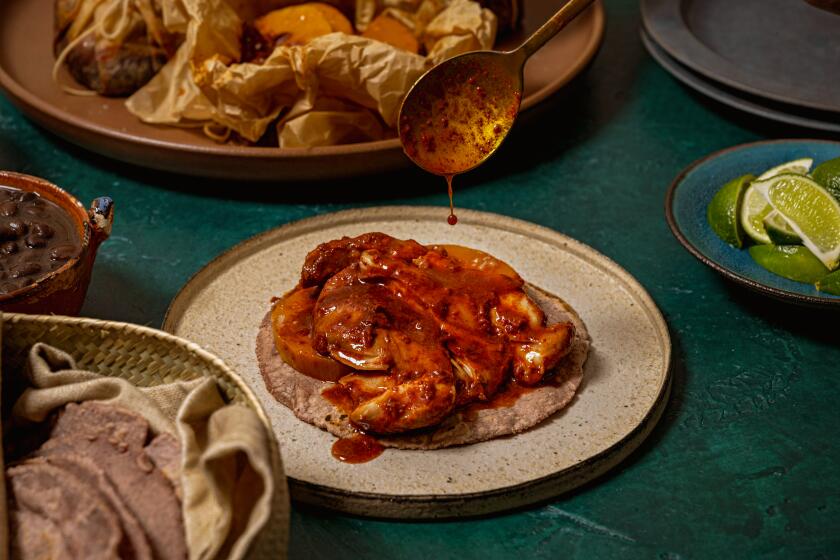Butter-Poached Lobster Tail With Sauce Fines Herbes
- Share via
Butter is our favorite fat, but it is rarely used to its fullest advantage in the home kitchen, where it’s confined to gentle sautes and as a spread for vegetables and toast. One of its best uses, common in the professional kitchen, is as a simple preparation called beurre monte. It’s easy to make and will expand exponentially a home cook’s dinner party repertoire.
Beurre monte is an emulsion, something too many home cooks seem to fear. An emulsion is only a uniform mixture of two substances that don’t readily combine by themselves, like oil and water. A vinaigrette is an emulsion. So is mayonnaise.
In fact, a stick of butter is an emulsion. You can see that when butter melts, separating into clear fat, milk solids floating on top and water at the bottom.
Beurre monte is butter that has been whisked into a couple of tablespoons of liquid, piece by piece, to maintain the emulsion. When it is done, it will look creamy and fluffy, almost like a hollandaise sauce.
Beurre monte is an extraordinary ingredient that can be used in numerous ways. It’s a stellar cooking medium: Lobster tail, removed from its shell and poached in beurre monte, is like none other you’ve tasted--sweet, rich and remarkably tender. The addition of water gives the lobster a silky texture wholly unlike that of lobster fried in plain butter.
It is also the perfect baste for pan-roasted meats. A few spoonfuls of beurre monte over a pork tenderloin, filet mignon or chicken breast keeps the meat moist, flavors it, helps to ensure even cooking (since fat conducts heat so uniformly) and gives it a beautiful browned color.
You can even use it as a warm butter bath to rest meat in before it is served. A sauteed veal loin resting submerged in beurre monte maintains the perfect temperature and does not dry out; the density of the surrounding butter prevents juices from leaking out of the meat. You can then add some of that same beurre monte to a saucepan with some sweated shallots and, say, a puree of watercress, for an elegant sauce to serve with the veal.
The keys to working with beurre monte are simple:
* Cut the butter into chunks before you begin. You don’t want to have to interrupt the whisking.
* Make sure the liquid into which you’re emulsifying the butter is near or at a boil (but don’t let it boil away).
* Once the butter begins to melt and a liquid emulsification is formed, lower the heat so that the beurre monte doesn’t boil; if it boils, the emulsification can break.
* Once the beurre monte has been made, cover it with plastic wrap or a tight-fitting lid and keep it in a warm place; it can be kept for hours until you’re ready to use it. Any that is left over can be stored in the refrigerator, where it can be clarified to be used for frying.
It can also be eaten straight as a dipping sauce for bread. That’s what we do with it in my kitchen. No wonder the staff keeps gaining weight.
Thomas Keller is chef at the French Laundry in the Napa Valley. He and Michael Ruhlman are co-authors of “The French Laundry Cookbook” (Artisan, $50). Previous columns by Keller and Ruhlman can be found on The Times’ Web site at: http://www.latimes.com/keller.
Fill large pot with enough water to completely cover lobsters. Add vinegar and bring to boil. Remove from heat and submerge lobsters.
Steep lobsters 2 to 3 minutes. Remove lobsters from water, twist to remove knuckles and claws and return these to hot water.
Separate tails from body of lobster (reserve body for stock or discard). Cut through cartilage on underside of lobster, pull apart and pull out tail meat in 1 piece. Cut tail in half lengthwise, remove vein and trim any loose strands. Remove claw meat intact by wiggling off small lower claw, to which a piece of cartilage is attached (be sure to remove this cartilage if it separates) and by cracking fat claw near its base to open and remove meat without damaging it. Remove knuckle meat and reserve for another use (it’s great sauteed quickly in butter for a snack). Place all meat on paper-towel-lined plate, cover with plastic wrap and refrigerate until ready to use. (Allow lobster meat to sit at room temperature 1 hour before cooking if chilled.)
To make beurre monte, bring 2 tablespoons water to simmer in large saucepan. Whisk in butter, 1 piece at a time, reducing heat to low and being careful not to boil butter. Submerge lobster tail in butter and poach over low heat until heated through, 5 to 6 minutes. (Optimum temperature of beurre monte is between 180 and 190 degrees.)
While lobster poaches, saute shallot in 1 teaspoon beurre monte over medium heat, 2 to 3 minutes.
When lobster is cooked, remove to warm plate, add 1 cup beurre monte to shallots, then add herbs. Heat over medium heat until beurre monte is hot but not boiling.
To serve, place 1 claw on top each half lobster tail and serve with sauce in warm dish. (You’ll use about 1 cup. Leftover lobster-infused butter can be refrigerated, clarified or not, and reused for sauteing.)
Get our Cooking newsletter
Get a taste of Los Angeles — and the world — with recipes and kitchen tricks from the L.A. Times’ Cooking newsletter.
You may occasionally receive promotional content from the Los Angeles Times.















